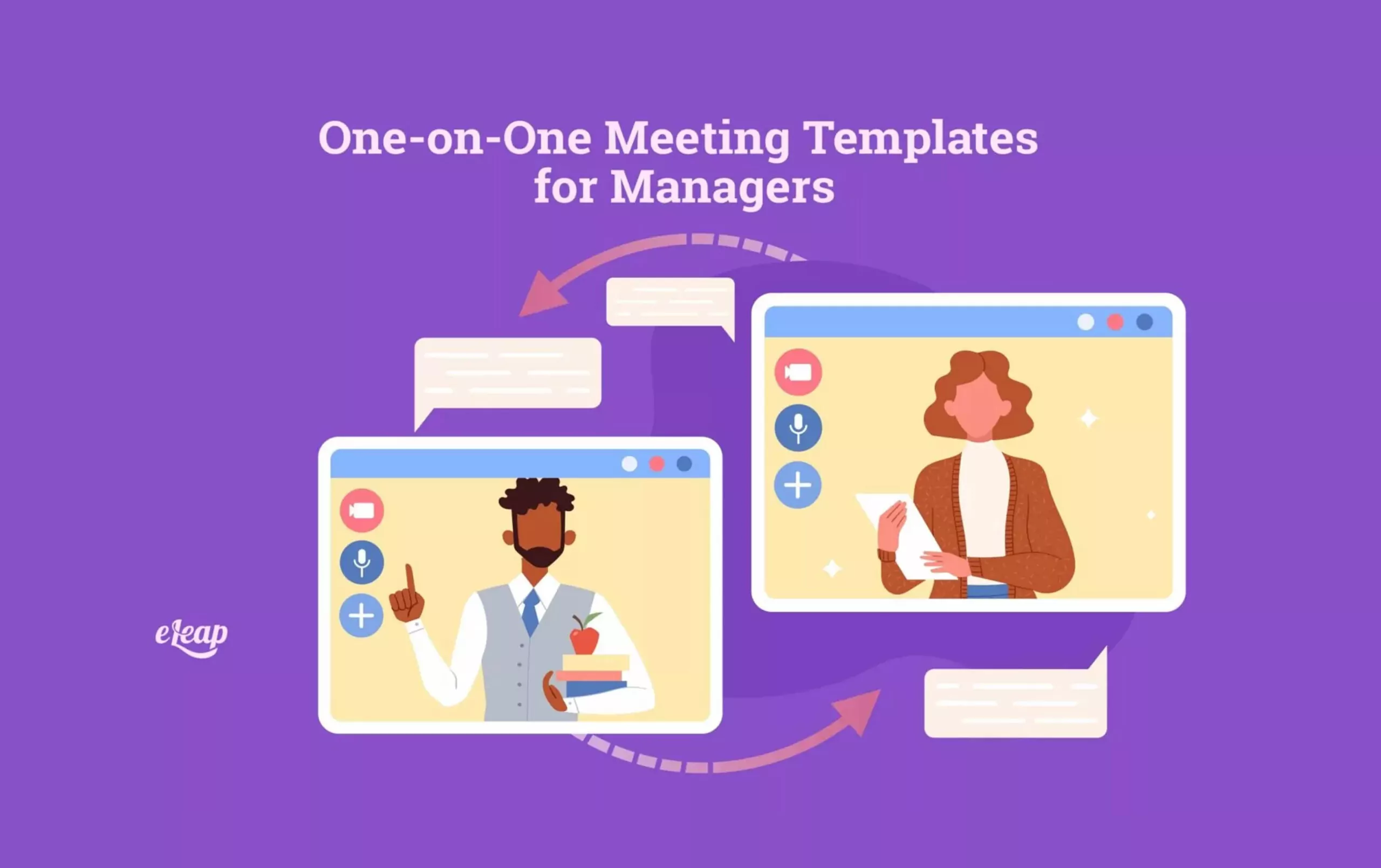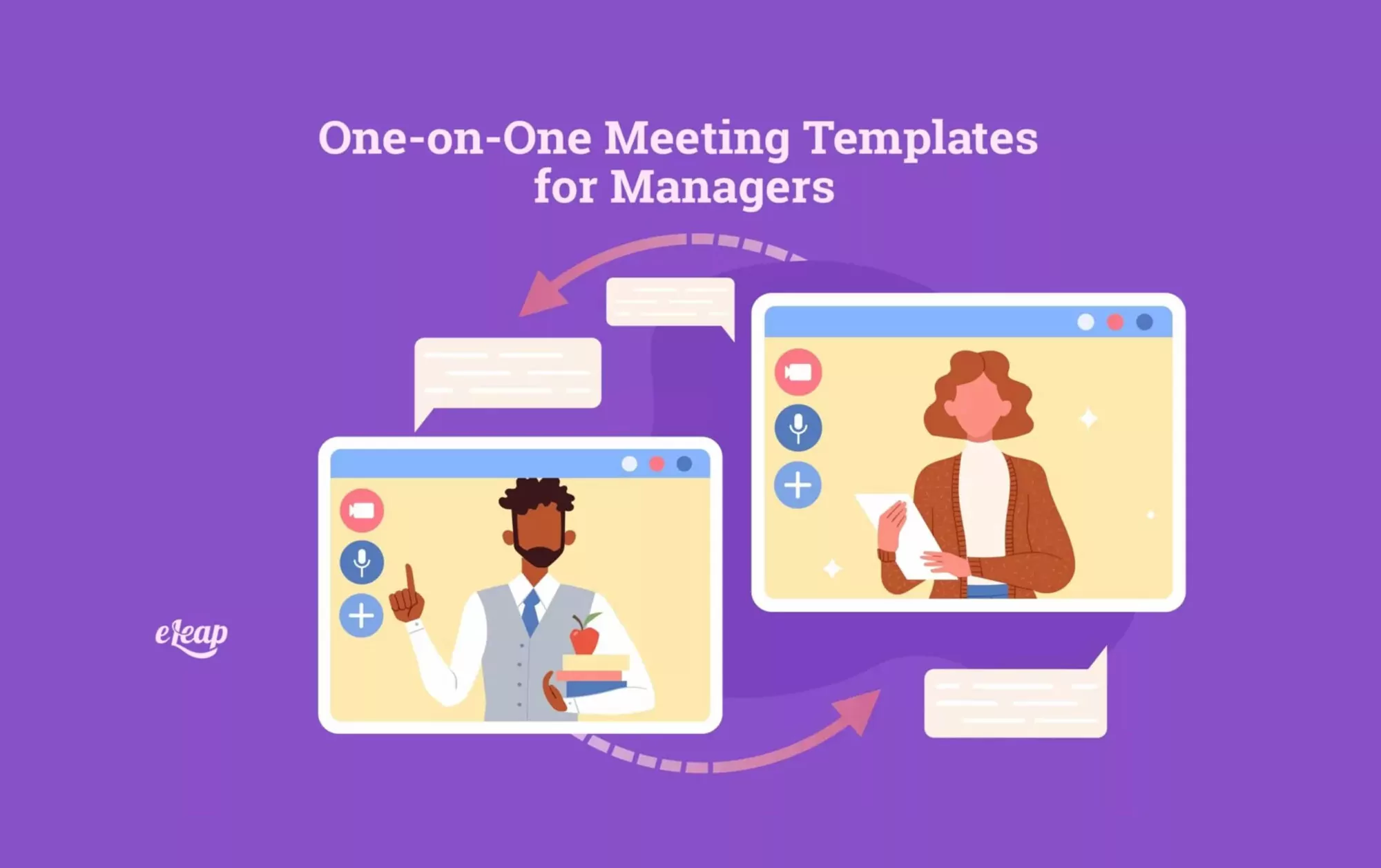One-on-One Meeting Templates for Managers

As a manager, you understand the value of one-on-one meeting templates to use in an effort to provide ongoing support and direction. One-on-one meetings have numerous advantages. In order to get from the one-on-one meetings, it’s essential to have a plan. A template provides you with a guideline and helps keep your meetings on track.

The Importance of One-on-One Meeting Templates
To ensure ongoing feedback, you need to implement one-on-one meetings. These biweekly or weekly meetings give managers and their staff members the chance to talk about hobbies, career goals, and chances for professional advancement. These meetings give managers undisturbed time to discuss projects, evaluate performance, clear obstacles, and other things with their direct reports. Additionally, it allows supervisors to learn more about their staff members personally. This is vital to engage staff members and increase their investment in your business.
When employees feel they are truly a part of the team, they work harder. This increases productivity and keeps morale high. Positivity also breeds positivity, so the more pluses you can add to your employees’ overall thoughts on the company and their position, the better.
Benefits of One-on-One Meeting Templates
Every organization, every boss, and every direct report should have various one-on-one sessions. The aim of these sessions is to preserve an effective line of communication between management and staff. Even though each manager’s method may differ, the core reason for having the one-on-one meetings should be the same. In addition, everyone can benefit from them when they’re done correctly. Listed below are some advantages that one-on-one sessions offer:
One-on-one’s may often be considered a part of the performance review. Frequent check-ins help managers monitor worker productivity and guarantee that team objectives will be accomplished. This does not mean that the one-on-one should solely be performance-focused. Still, it does allow more consistent communication regarding any issue that may arise.
One-on-one meetings are the ideal opportunity to talk about personal and professional progress because 87% of millennials prioritize growth and professional development in a career. Managers should take advantage of the opportunity to talk about their direct reports’ passion projects, professional development possibilities, and career goals. Your staff members will not only be happier and more productive at work, but they are likely to stay with your business for a longer period of time if you show interest in and invest in their personal development.
The creation and implementation of one-on-one meeting templates can increase trust by giving employees a chance to be themselves during these meetings. Managers and employees can use this time to learn more about each other and possibly establish enduring relationships. According to studies, when workers feel trusted at work, they are more self-assured and work harder. Employees with positive working relationships with their managers may also be more honest about personal matters that may harm their performance.
These meetings also allow employees to discuss roadblocks, difficulties, and problems with their supervisors when they arise. They also allow teams to shift course if their goals or objectives become obsolete, allowing them to remain flexible and adjust as business requirements evolve.
Possible Pitfalls of One-on-one Meeting Templates
While these meetings have fantastic benefits, you may also encounter some difficulties. You might find that not everyone is buying into the importance of the meeting and may not consider attendance to be required. This could be on either the supervisor or the management side.
Despite scheduling these meetings in advance, you might hear some employees or managers rushing through the meetings and not truly taking the time to cover everything on the agenda. If this is done on the manager’s side, it is the same as telling the employee their time and thoughts aren’t valued, which is the exact opposite of the goal of one-on-one meeting templates.
In addition, neither party may be in a position to listen to the other. This often happens when they are ill feelings or a lack of respect between the two. As the manager, this is something you should be aware of. Create a plan with the supervisor or a third party to ensure the meetings are constructive and work to build a positive relationship.
What Should the One-on-One Meeting Template Contain?
There are a variety of ways you can formulate your meeting template. Three options are detailed below.
Split Time Template:This meeting structure allows you and your employees time to discuss what is on their minds, each given a spot on the agenda. It should be employee-driven, though. This can be difficult when the employee might not feel comfortable talking or seems to be holding back for some reason. As a manager, it’s important to use effective communication skills to pull employees out of their shells.
Within this one-on-one meeting template, you can set up talking points for moments when conversation stalls. This provides you the opportunity to ask the employee open-ended questions that will further the goals of the meeting. With time, employees will become more comfortable with this format, especially as they see their thoughts and opinions are valued.
Core Area Template:This one-on-one meeting template allows the manager to create topic areas to hit, focused on a variety of subjects ranging from issues that need to be addressed to simply learning more about each other. In this template, you should always ask personal questions first. Ask about their kids or family or the hobbies they enjoy. Taking the time to learn more about them lets them know that you are invested in the time you spend with them.
Using this one-on-one meeting template, you should focus on a few main areas, depending on the nature of your one-on-one. An interaction piece focuses on the employee and their role in the company. You can ask them what they enjoy about their job and what else they might like to learn.
A second section goes into teamwork and how they work within their team. Are there things they would change or difficult relationships within the team? Is there something you, as the supervisor, can work on to increase the team’s productivity?
Depending on the nature of your one-on-one, whether they be purely relationship based or have an added performance section, you would include their work projects and any issues with deadlines they may be encountering during this time as well.
Last but not least, you would have an area to discuss goals and feedback. It’s important not to rush through any of these sections so if this is the template format you suggest, mind your time appropriately.
Timeline One-on-One:This one-on-one meeting template is just as it sounds. It is timeline-based, focusing on historical as well as present and future workings. This template might border on focusing too much on the workspace and not enough on the employee, so a good manager will need to navigate the communication as they see fit.
Setting a Good Example With One-on-One Meeting Templates
When it comes to one-on-one meetings, it’s safe to say that you will get out of it what you put in it. As the manager, you need to earn the buy-in of your supervisors on this task before you can ask them to go full throttle with their staff. When managers see the effort you’re putting forth to also get them engaged, they will feel motivated to do the same with their team.
Discuss one-on-one meeting template types with your management team and see what they are comfortable with. They may have alternate ideas than the ones discussed here. A simple search provides a wealth of options. You may find that your managers gravitate to different template styles. This makes sense as each manager works with their staff in a different way. Plus, each department might function differently, requiring a different set of questions.
For instance, if one of your managers supervises a remote team, they might like the same template as someone who sees their employees each day. Decide as a team what approach you will take, as well as the time allotted and frequency for the one-on-one meetings. Then set a plan to discuss the meetings with your employees to get them used to the idea. For some, they might be guarded, while others will look forward to the chance to spend uninterrupted time with their supervisor.
Another point to make is that these meetings should truly be one-on-one. There may be the opportunity to add in group meetings as well, but do not put off the one-on-one opportunities and what you can learn from them.
Summary
You should understand a bit more about the importance of one-on-one meetings in the workplace and how to create a one-on-one meeting template that works for you. There are no right or wrong ways to approach this topic as long as your main intent stays true. The meetings should focus on building a relationship with employees to further acclimate them to the business and build up their self-confidence in their role as team members. Remember, you are working to build from within, and the best opportunity to do that is to provide each team member with the respect they deserve. The eLeaP continuous performance management system provides organizations with powerful options to attract and retain high caliber team members.